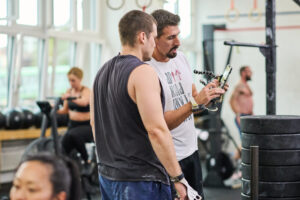
If you’re constantly tired, sore, unmotivated, or feeling like your workouts just aren’t working anymore, you might think you’re overtraining. But here’s the truth:
Overtraining is extremely rare.
Under recovery is incredibly common.
And while the symptoms may look the same—fatigue, sleep disruption, poor performance, irritability—the fix is completely different. Here is our take on overtraining vs. under recovery:
What is overtraining?
Overtraining means you’ve been consistently training too hard, too long, with too little rest, pushing your body past its ability to recover. It typically requires months (or even years) of intense, high-volume training without proper deloads, nutrition, or recovery protocols. Think elite athletes in competition prep, not your average gym-goer who trains 4–6 times per week.
If your program is smart, progressive, and well-coached—like it is at a CrossFit gym that prioritizes quality—you’re very unlikely to overtrain. But…
What is under recovery?
Under recovery is when your lifestyle doesn’t support your training. You’re not sleeping enough. You’re skipping meals. You’re stressed, dehydrated, glued to screens, and trying to survive on coffee and willpower.
Under recovery is not about doing too much in the gym—it’s about not doing enough outside the gym.
Same symptoms, but different solutions
Here’s the catch: the body doesn’t care whether it’s under-recovered or overtrained—it just sends out the same SOS signals.
So how do you know which one it is?
Ask yourself:
- Am I sleeping at least 7–8 hours per night?
- Am I eating enough food to fuel my training and daily life?
- Am I managing stress—or numbing it with late-night scrolling, snacks, and Netflix?
- Do I walk, move, and breathe well outside of training?
If the answer is no to most of those questions, you’re not overtrained—you’re under recovered.
Why reducing training load isn’t the long-term fix
Taking a few days or even a couple of weeks off training can help in the short term—but if the underlying problem is lifestyle-related, it won’t solve much.
You’ll feel better when you rest. But if you return to the same sleep-deprived, poorly nourished, overstimulated routine, the symptoms will come back—even if your training volume stays low.
And that’s the real danger. Many people start blaming exercise itself and reduce or quit training altogether. This might help for a week, maybe a month—but if it continues for months or even years, your training volume drops too low to support long-term health.
You lose strength, power, and resilience. You increase your risk of injury, illness, and age-related decline.
In short: too little training is just as harmful as too much.
So what should you do?
Instead of cutting back on movement (which your body needs!), try fixing what’s missing in your recovery process:
- Sleep: Go to bed 30 minutes earlier. Use a wind-down routine.
- Nutrition: Eat real food, consistently, and enough of it.
- Movement: Don’t just train—move throughout the day. Walk. Stretch. Breathe.
- Stress: Journal. Talk. Laugh. Set boundaries. Say no.
Also, consider this: you might not be fit enough—yet—to support the amount of high-intensity training you’re doing. That might sound strange, but it’s common. In that case, the solution isn’t to stop training—it’s to shift the type of training.
Temporarily reduce high-intensity sessions and replace them with low-intensity cardiovascular work, like walking, biking, or easy rowing. This doesn’t mean training less—it often means training more, but at a lower intensity. This builds aerobic capacity, improves recovery, and lays the foundation to handle intensity again later. Long-term health and fitness require a strong aerobic base—not just sweat and soreness.
Talk to your coach about your training plan and they will be able to help you to prioritise the most effective life style changes in your particular case.
Final thought
You don’t need less training—you need more recovery. And sometimes, you need to train differently, not less. Under recovery is a real thing.
Instead of asking “Am I doing too much?”
Start asking “Am I recovering enough for what I’m doing?”
Or even: “Am I fit enough to do what I’m trying to do?”
At our gym, we train hard—but we also coach lifestyle, recovery, and sustainable progress. We help you recognize the difference between pushing limits and pushing too far.
Because fitness isn’t just what happens in the gym. It’s what you do with the other 23 hours that truly builds results.




